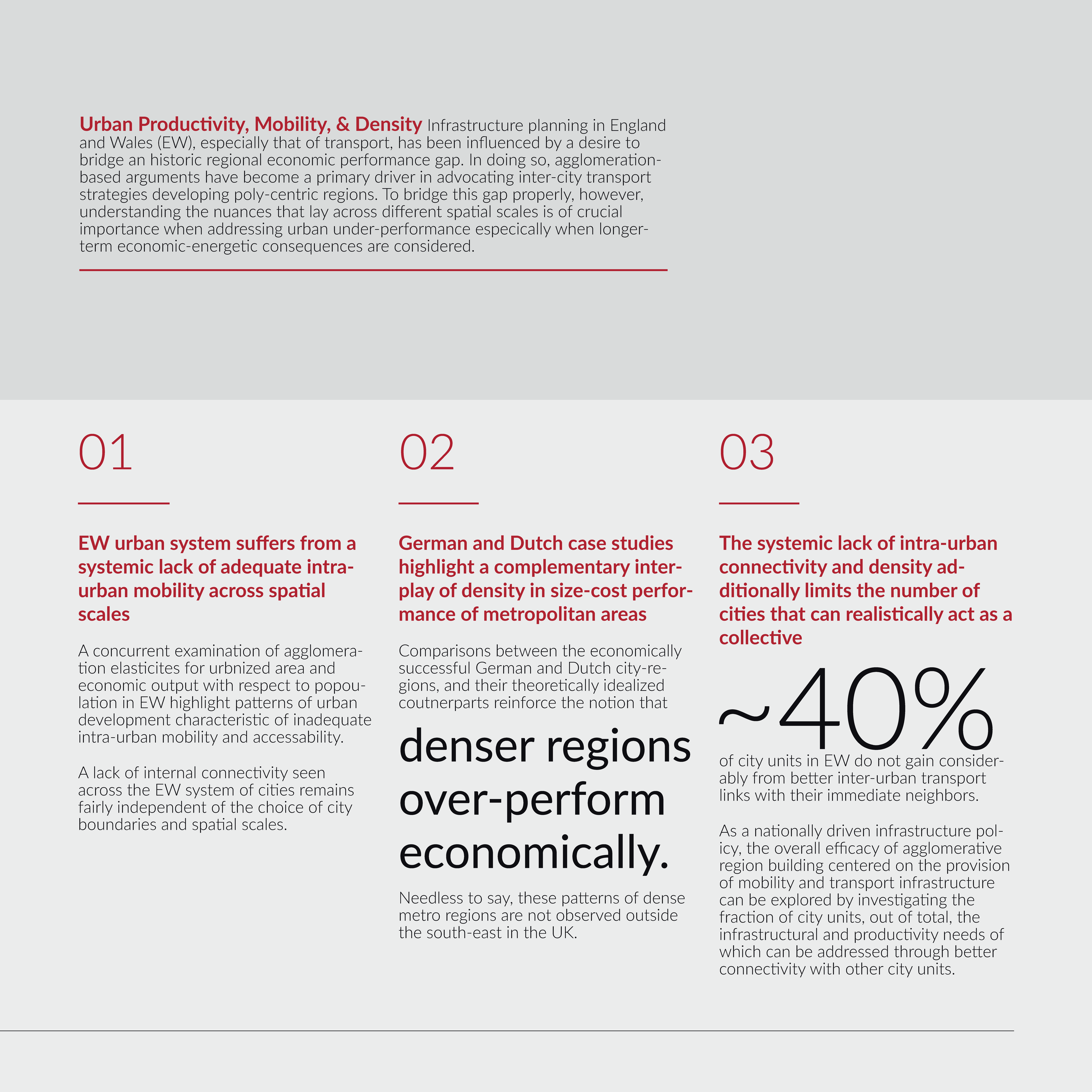this is the main project i focused on throughout my phd work.
understanding the nuances at play across different spatial scales is of crucial importance when considering urban economic-energetic size-cost performance, specifically when longer-term consequences are considered. through the application of an allometric understanding of cities, this project offers a more nuanced narrative highlighting the interplay of urban productivity and spatial configurations of human interactions across scales.
the whole ordeal is documented in three papers and the associated doctoral monograph itself.
references
papers
-
Productivity, Infrastructure and Urban Density—an Allometric Comparison of Three European City Regions Across Scales
Journal of the Royal Statistical Society: Series A (Statistics in Society), 2020
Agglomeration-based arguments citing Dutch and German city regions have been a primary driver in advocating intercity transport strategies in the north of England.We adopt an allometric urban model investigating the applicability and transferability of these transport-led agglomerative strategies promoted to address England’s regional economic underperformance. This is undertaken through a comparative study of the size–cost performance balance of three city regions and the overall urban networks in the Netherlands and Germany, and England and Wales by using city units defined at different spatial scales. Although our results support a case for better mobility and transport comparing the three urban networks regardless of the spatial scales, comparisons of specific city regions indicate a more nuanced interplay of productivity, mobility infrastructure and urban density.
-
On the Development Logic of City-Regions: Inter- versus Intra-City Mobility in England and Wales
Spatial Economic Analysis, 2019
This paper combines an allometric urban model with a hierarchical clustering method in order to investigate the effects of distance and spatial scale on the geography of transport-led agglomerative strategies implemented to address comparative regional economic underperformance. The study is undertaken in the context of the urban system in England and Wales by constructing agglomerated city-regions using city units defined at different spatial scales. As is shown, a greater importance than is currently given lies in local and intra-city mobility as compared with longer distance transport schemes promoted using agglomeration theory principles. This signals a need for prioritization of mobility improvements at smaller intra-urban distances coupled with long-term densification efforts as integral to the performance of longer distance inter-city pairings.
-
Urban Performance at Different Boundaries in England and Wales through the Settlement Scaling Theory
Regional Studies, 2019
The relationship between transport-led agglomeration and economic performance is evaluated in an English and Welsh context. We examine the effects of scale, i.e., inter- versus intra-city mobility infrastructure, on urban size–cost performance. An additional contribution of this paper lies in its use of power-law scaling models of urban systems, enabling an assessment of optimality in the trade-off between economic output and mobility costs accounting for ease of access within cities coupled with their built density. Findings suggest economic underperformance coincides with inadequate mobility at both inter- and intra-city scales, while overperformance is accompanied by overgrown urbanized area and escalating mobility costs.
thesis
-
Urban Productivity & Spatial Patterns Across Scales: A Multi-Scale Exploration of Urban Networks and Their Hierarchical Configurations
Hadi Arbabi
University of Sheffield, 2019
Understanding the nuances at play across different spatial scales is of crucial importance when considering urban economic-energetic size-cost performance, specifically when longer-term consequences are considered. Through the application of an allometric understanding of cities, a more nuanced narrative is offered highlighting the interplay of urban productivity and spatial configurations of human interactions across scales. This is presented in three parts. In the initial examination of the urban economic-energetic size-cost balance across spatial scales, we seek new insights on the effects of scale in relation to urban connectivity and density for maximizing urban size-cost balance. For this, we use the urban system in England and Wales as a topical testbed where agglomeration-based arguments have been used in support of better inter-city connectivity in order to address a historic North-South regional economic productivity divide. The inadequate connectivity thought to be affecting the economic performance across the urban network in England and Wales, however, is shown to permeate across spatial scales. More broadly, this points at a scale-induced hierarchy of urban connectivity concerning potential improvements needed at inter- and intra-city scales. This is followed by an examination of the universality and transferability of scaling insights, and their nuances, between different cities and systems of cities. Considering the current transport schemes designed to address the North-South economic gap, we examine the continental comparisons drawn specifically from the inter-city transport infrastructure connecting the Randstad in the Netherlands and Rhine-Ruhr metropolitan region in Germany. Our examination points towards fundamental differences that exist in the structure and distribution of population density across the countries and their city-regions across various scales. Additionally, the cross comparison demonstrates that, although scaling insights are transferable between urban systems, a simple multi-scale assessment of individual systems of cities in isolation is sufficient when investigating urban connectivity from an urban allometric point of view. Finally, returning full circle to the effects of spatial scales and distance on the geographical patterns of urban connectivity, we review a mathematically grounded approach to sort and organize the intra- and inter-city connectivity hierarchy while matching complementary infrastructural needs based on size-cost balances for a number of different scenarios. Together, this narrative provides a somewhat enhanced and most crucially spatially multi-scale examination of the arguments regarding connectivity and agglomeration in an urban context.
